



Guarding the Country Against Foreign Animal Diseases
Researchers based at the USDA Agricultural Service (ARS) Plum Island Animal Disease Center have been making progress on the development of vaccines against major livestock diseases such as Foot and Mouth Disease (FMD), Classical Swine Fever), African Swine Fever (ASF) and Vesicular Stomatitis, writes Sandra Avant of the ARS.A deadly animal virus is on the loose, treading through Russia and knocking on the doors of Eastern Europe and Asia. After its introduction into the Republic of Georgia and the Caucasus region in 2007 and spread into Russia, the virus that causes African swine fever (ASF) was spotted for the first time last year in Ukraine, putting European and Asian countries on high alert. The virus moves quickly, killing 100 per cent of infected pigs within a week in some instances.

[Photo: Keith Weller]

[Photo: Kathleen Apicelli]
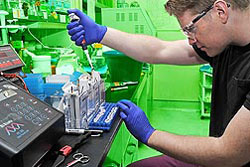
[Photo: Kathleen Apicelli]
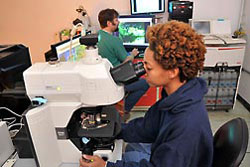
[Photo: Kathleen Apicelli]
Standing between a possible US invasion by foreign animal diseases like ASF is the Plum Island Animal Disease Center, situated off the northeastern tip of Long Island, New York. For almost 60 years, the Center has served as somewhat of a fortress, where a small force of scientists tackles dangerous diseases that threaten the health of livestock and world economies.
In 1954, the US Department of Agriculture’s Agricultural Research Service took over Plum Island from the US Army to establish laboratories where scientists could find ways to prevent and control exotic diseases that threaten US livestock production and global food security.
The primary objective was to develop methods to detect and prevent foot-and-mouth disease (FMD), an economically devastating disease. FMD was eradicated from the United States in 1929 but today, it is spreading throughout Asia and Africa. Recent outbreaks have occurred in the United Kingdom, Bulgaria, Japan and South Korea.
Working with other agencies, scientists in the ARS Foreign Animal Disease Research Unit (FADRU), at Plum Island, also keep diseases like ASF, classical swine fever and vesicular stomatitis at bay.
In 1984, a USDA Animal and Plant Health Inspection Service (APHIS) team took over diagnostic work, leaving the basic research to ARS scientists. Another change occurred in 2003, when Plum Island operations were transferred to the US Department of Homeland Security (DHS), which works with USDA in the advanced development of vaccines and diagnostic tests to help control and respond to disease outbreaks.
Tracking FMD: The Infection Site
The Plum Island Center provides a safe setting for studying FMD, which affects cloven-hoofed animals like cattle, swine, sheep, goats and deer. The highly contagious disease is rarely fatal in adult animals but it debilitates its victims and can cause large-scale death of young animals. Incursions of FMD cause profound economic consequences through isolation from trade, loss in milk production, severe lameness, and massive depopulations. When the virus has been introduced in FMD-virus-free countries, millions of animals - infected and uninfected - have been euthanised after outbreaks to prevent the virus from spreading.
A breakthrough in FMD research came in 2010 when veterinary medical officer, Jonathan Arzt, identified the site where FMD virus initiates infection in cattle. Working with FADRU research leader Luis Rodriguez and microbiologist Juan Pacheco, Dr Arzt found that the virus selectively infects epithelial cells in the back of the cow’s throat.
“Now that we’ve determined the actual route the virus takes in infected cattle, we can try to develop new vaccines and biotherapeutics to target and prevent virus infection of the primary site and potentially control and eradicate FMD,” Dr Arzt said. “Blocking the initial site of infection is the best way to achieve complete protection.”
There are seven FMD virus serotypes—O, A, C, Asia-1, SAT-1, SAT-2, and SAT-3. Scientists detected the infection site using serotype O and have since had the same success with serotype A.
“The work with serotype A elevates our level of confidence even higher,” Dr Arzt explained. “We now know that what we found with serotype O was not an anomaly or isolated finding.”
In other work, scientists have helped build an infrastructure for testing, biosecurity measures, and identification of FMD virus strains in Vietnam and Pakistan.
“Our goal is to help them discover how FMD outbreaks are initiated under natural conditions so they can protect their own herds, but it also gives us an advance look at the FMD virus strains that are currently emerging and circulating,” Dr Arzt said.
The First Line of Defence
In the last 15 years, FADRU scientists have proven that interferons - proteins made and released by host cells in response to the presence of viruses or other pathogens - protect against FMD. Interferons act as antiviral agents that kill the virus or stop it from multiplying and reproducing.
“They are the first line of defence and response against viral infection,” says microbiologist Teresa de los Santos. “They protect animals immediately, giving the vaccine time to induce the immune response needed to fight the disease.”
This is potentially a very important tool for controlling FMD outbreaks because FMD spreads very rapidly; by the time animals are vaccinated, the virus may have already spread to other herds.
There are three families of interferons; type I (interferon alpha-beta), type II (interferon gamma) and type III (interferon lambda). Retired ARS chemist, Marvin Grubman, demonstrated that type I is very effective in controlling FMD virus infection in swine.
“We can inoculate swine with a viral vector containing the gene coding for swine type I interferon and then challenge them with FMD virus 1 day later and protect them,” Dr Grubman said. “Type I interferon protection could last approximately five days, so we still have a couple of days to cover before the vaccine immunity kicks in at about day 7 post vaccination.”
Vaccines require seven days to induce protection against FMD, leaving vaccinated animals susceptible to infection during that time. Therefore, scientists are trying to cover that window of susceptibility by combining interferons with vaccines.
By combining type I and type II interferons, Dr Grubman produced another patented antiviral vaccine-delivery technology that rapidly blocks FMD virus in pigs. In combination with a vaccine, it provides thorough protection from day 1 until the vaccine immune response kicks in. However, this approach has not been as successful in cattle.
De los Santos and FADRU computational biologist, James Zhu, have discovered a solution to the problem of rapid protection of cattle. The Plum Island team was the first to report and identify a type III interferon in cattle. They also demonstrated that type III interferon is effective against FMD virus in cattle as early as 1 day after vaccination.
“We first discovered that a member of the type III interferon family could actually inhibit FMDV replication in cell cultures,” Dr de los Santos said.
“We then inoculated cattle with a viral vector that delivered bovine type III interferon and challenged with FMD virus 24 hours later. We saw a significant delay in the appearance of clinical signs in animals that received type III interferon as compared to those given type I interferon or no treatment. In other experiments, where cows were naturally exposed to FMD virus, the type III interferon treatment was even more protective,” she added.
Scientists also constructed a mutant virus, called 'SAP-mutant', which has a mutation in one of the virus’s proteins, named 'leader'. They used the SAP-mutant to develop an attenuated (weakened) FMD vaccine, which when administered to pigs can protect them against challenge with virulent FMD virus.
Working with Dr Zhu and other colleagues, Dr de los Santos used a reverse genetics approach to understand the basis of attenuation of the SAP-mutant. Unlike classical genetics, which seeks to find the genetic basis of a trait or phenotype, reverse genetics attempts to find what trait appears as the result of a particular gene mutation.
“We learned that the SAP-mutant virus was unable to interact with some host proteins involved in innate immunity,” Dr de los Santos explained. “Therefore, the virus was less infectious and could potentially serve as the basis for an effective live attenuated FMD vaccine candidate.”
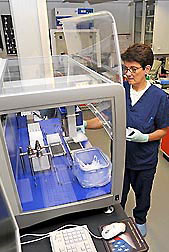
[Photo: Kathleen Apicelli]

[Photo: Kathleen Apicelli]
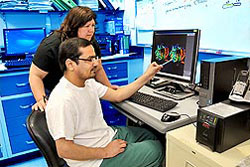
[Photo: Kathleen Apicelli]
Producing FMD Vaccines Safely
In other research, a team led by microbiologist Elizabeth Rieder has designed new technology for producing FMD vaccine without the need of virulent virus.
“We cloned the FMD virus genetic material in a plasmid [a small DNA molecule], which allows us to introduce mutations and produce deletions in the virus and understand the functions of particular parts of the virus genome,” Dr Rieder explained.
Researchers identified a sequence that, if removed, renders the FMD virus harmless to animals while still leaving it capable of growing in cell culture.
“It has allowed us to understand how the virus amplifies itself, interacts with a host animal, and inhibits its defense mechanism and how different parts of the virus genome function,” Dr Rieder continued. “This is important basic knowledge we can use in developing vaccines or biotherapeutics.”
Scientists used this technology to produce a new FMD vaccine. This technique is safer than current technology, which uses naturally occurring (wild-type) virus, because the attenuated FMD virus does not cause disease in animals, Dr Rieder said. In addition, the virus used in the vaccine has been labelled with unique markers to differentiate it from wild-type virus found in outbreaks.
A patent has been filed for the new technology, which is being developed for vaccine production by a private company.
Insights from Human Technology
Immunologist William Golde and his team were the first to try - in swine - a technology used by physicians to type humans for organ transplants. The team used it in swine and cattle to measure specifically immune responses to FMD vaccines.
The technology, called 'major histocompatibility complex (MHC) tetramers', allows scientist to follow immune responses mediated by individual T-cells. MHC is a molecule located on the surface of a cell that mediates interactions of white blood cells with other body cells.
“The human technology translated very readily to swine and cattle,” said Dr Golde. “Combining it with new technologies to track individual B cells [antibody-producing cells], we’ve been able to track immune responses to vaccines and to infections with greater accuracy.”
Dr Golde’s other work includes testing an automated, needle-free, vaccine-delivery device called 'DermVac', which induces stronger immunity with less FMD vaccine. Animals vaccinated by this method, with just a fraction of the recommended vaccine dose, were protected from disease when infected with FMD at seven or 28 days after vaccination.
“We achieved effective protection against FMD with less than the recommended vaccine dose,” Dr Golde added, “showing that the vaccine’s potency was enhanced when delivered with this device.”
A Classic Case of Pig Virus
Although classical swine fever (CSF) has been eradicated in the United States, the contagious, sometimes fatal disease is present in wildlife in Europe, where infected wild boar can transmit it to domestic pigs.
“Once the disease is detected, all animals in close proximity of infected pigs must be destroyed, creating a huge economic problem,” says microbiologist, Manuel Borca. “Vaccination is banned in Europe but it would be considered if a marker vaccine is developed.” A marker vaccine allows vaccinated animals to be distinguished from those infected with wild-type virus.
Under the leadership of Dr Borca, scientists at Plum Island have been using different strategies to develop virus strains for vaccines that meet these criteria. They identified 10 to 12 different areas of the virus genome that, if mutated, cause the virus to become attenuated.
Using this approach, a CSF virus was genetically manipulated not only to attenuate it but also to introduce a genetic marker that can distinguish it from wild-type virus. Dr Borca received a patent for this marker virus, which produces early immunity within the first week of vaccination.
Earlier CSF work at Plum Island included the development of a rapid diagnostic test, based on real-time PCR (polymerase chain reaction), which detects the virus in infected animals two to four days before clinical signs appear.
“The test was further validated using field samples in the Dominican Republic,” Dr Borca added. “We showed that it works in field conditions.”
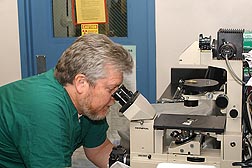
[Photo: Kathleen Apicelli]
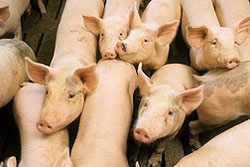
[Photo: Regis Lefebure]
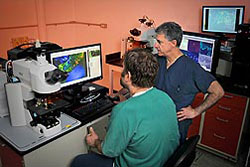
[Photo: Kathleen Apicelli]
Spread of a Deadly Swine Disease
An outbreak of African swine fever (ASF) in the Republic of Georgia and surrounding countries in 2007 prompted ARS to renew efforts to find ways to prevent or control this serious disease, for which there is no cure or vaccine. Concern over ASF is heightened by its unrelenting spread towards Europe since 2007. Its clinical signs are similar to those of CSF but ASF is more uniformly fatal. Pigs suffer from high fever, haemorrhages, vomiting and loss of appetite.
“African swine fever has many strains that are extremely infectious,” Dr Borca explained. “All infected animals die within a week.”
All attempts to produce effective vaccines have been unsuccessful so far because of the complexity and large size of the ASF virus.
“It has a large genome of more than 150 genes, making everything more complicated,” Dr Borca said. “It is more difficult to research the ASF virus than the smaller viruses, like CSF.”
In earlier years, scientists at Plum Island made significant progress in understanding the role of particular ASF virus genes in causing disease. Dr Borca was part of a team that was able to characterise several genes that are important in virulence.
“If you eliminated some of those genes, the virus became somewhat attenuated,” Dr Borca said. “This approach was used at that time to develop less-virulent viruses that could be tested as vaccine candidates.”
Animals given the attenuated viruses and later challenged with a virulent virus were protected against ASF, he says.
After a seven-year lapse in ASF studies due to limited funding, research has been re-initiated by ARS scientists, under Dr Borca’s leadership, using these same techniques.
He said: “In the last two years, we have produced recombinant viruses, using the ASF strain that is killing thousands of animals in the Caucasus region, by eliminating the genes previously identified as important for attenuating the virus. We are now testing those viruses in animals to see if they are attenuated and if they could be used as vaccine candidates.”
A Blistering Battle
Another livestock invader is vesicular stomatitis virus (VSV), which rarely occurs in the United States but can infect humans and some wildlife species.
“It looks like foot-and-mouth disease - blisters on the tongue, mouth, and fleshy parts of the feet,” Dr Luis Rodriguez said. “However, VSV affects horses and FMD does not.”
No effective vaccines are available for the disease, and the virus is transmitted by insects. “Black flies and sand flies are involved, as are the tiny culicoides insects, also called ‘no-see-ems,’” he added.
Working with scientists in Mexico, Dr Rodriguez recently traced the origin of a large number of 2008 outbreaks in northern Mexico to southern Mexico. He identified the virus strain and predicted that it might spread to the United States. Indeed, this virus was the cause of outbreaks in New Mexico in 2012.
“We discovered that the virus that occurred in the United States actually comes from Mexico, but we don’t know how it gets here,” Dr Rodriguez said. “We think it’s by insects and have found that if we protect animals from bug bites, we can decrease the impact of the outbreak.”
Teamwork’s the Key to Success
While ARS scientists at Plum Island work with universities, industries, international organisations and governments, their innovative technologies and discoveries are enhanced by APHIS and DHS support.
The main goal is to prevent and control foreign animal diseases by developing improved tools for diagnosing diseases and creating safe, faster acting vaccines and biotherapeutics.
APHIS confirms diagnostic tests and technologies for surveillance, detection and response to disease threats. DHS assists in developing vaccines and other countermeasures required for an effective response to a foreign-animal-disease outbreak on US soil.
This diligent teamwork at Plum Island helps protect livestock, humans and food supplies from diseases that put America at risk.
October 2013







